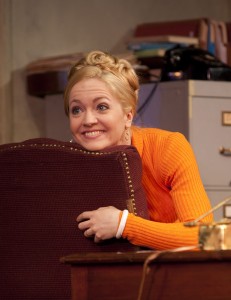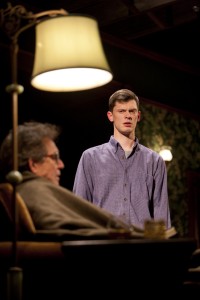
Jane Pfitsch as Rita in Educating Rita, by Willy Russell, directed by Maria Aitken at the Huntington Theatre Company, 3/10/11 Set Design Allen Moyer Costume Design Nancy Brennan Lighting Design Joel E. Silver © T Charles Erickson photoshelter.com/c/tcharleserickson tcepix@comcast.net
Educating Rita by Willy Russell, Huntington Theatre Company, 3/11/11-4/10/11. http://www.huntingtontheatre.org/ Herbal cigarettes smoked during the show.
Reviewed by Becca Kidwell
During my studies to become a teacher, I was told one of the movies that I should not see on education was Educating Rita. I can understand some of the caution; I would not want to be a teacher like Frank, but the story does remind us of the pure joy of learning and the need for critical thinking. Knowledge is more than expertise and understanding is more than results. The Huntington’s production of Educating Rita reminds us that learning should not be at the cost of of our individuality.
Being a perpetual student, Allen Moyer’s set had my “geeky sense” tingling–a room full of books and a sterile, air of pomposity–typical of a professor’s office. The office also hides the desperate desire of Frank (played by Andrew Long) to pretend that he is still an academic although he has been jaded for years. Life and renewed purpose enter Frank’s office in the form of Rita (played by Jane Pfitsch). Continue reading
